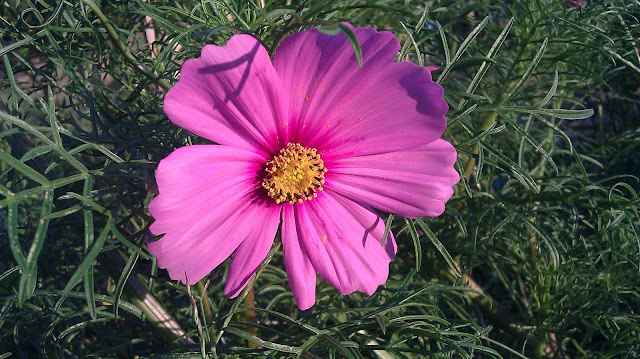I was walking around the garden yesterday and was surprised by the amount of flowers still in bloom. Having a large variety of plants flowering in your garden is beneficial in many ways. First is beauty, I will step out of my power tool infested man-cave and say, flowers make me happy, plain and simple. Secondly, flowers of different colors, shapes, and sizes bring all kinds of beneficial insects to your garden. Some of these insects are predators that help control insect pests, and some are pollinators that will help pollinate your food crops while they are in the area. Last but not least, many flowers have medicinal properties or are edible, or both. Here are some pics I took yesterday.
This is one of our favorite flowers in the garden. Cosmos (
Cosmos bipinnatus) is native to Mexico. The flowers attract birds and butterflies, and bees love them.
We bought a perennial flower seed mix that had dozens of different flowers in it. I am not sure what this is but it is a beautiful flower.
Same thing here, some kind of perennial flower. In the spring I plan on filling the beds along the back of the property with this mix.
Marigolds are very beneficial. They are said to deter some insect pests and bring in beneficial insects. This is a french marigold (
Tagetes patula), it is not edible, just beneficial. Some people confuse the inedible french marigold with the edible, sort of look a like, Calendula (
Calendula officinalis).
This is Borage (
Borago officinalis), which is very edible and delicious. The flowers continuously bloom all through the season. Bees love these flowers and they make a nice addition to a salad.
The first Jerusalem Artichokes (
Helianthus tuberosus) are blooming. I took this picture with the camera extended as high as I could above my head and the flower was still a few feet away. Right now these plants are around 10-12 feet tall. I did a detailed post on Jerusalem Artichokes
here if you are interested.
Not sure what this plant is. I was about to cut them all down when I noticed it was about to bloom. I am going to leave one and take the rest out. It has a very woody stalk that leads me to believe it might be a perennial. We will see if it comes back in the spring.
This is a perennial I bought in a big box store clearance sale. Not sure what it is, but it comes back every year and the bees like it.
Same here, this is a perennial from a clearance sale. I have a hard time passing up .50 cent flowering perennials.
My addiction strikes again. I often think about getting a part time job at my local big box store just so I can get first dibs on the clearance plants!
Yarrow (
Achillea millefolium) is a very valuable plant in the garden. It is a good companion plant, a medicinal and edible. It attracts predatory wasps, ladybugs and hover flies; all very beneficial to have around. It is said to improve the health of sick plants it is near to. Yarrow has been used for centuries as a pain reliever, an astringent, an anti-inflammatory, a diaphoretic and it was used in ancient times to stanch blood flow in wounds. In those days it was called
herbal militaris.
















